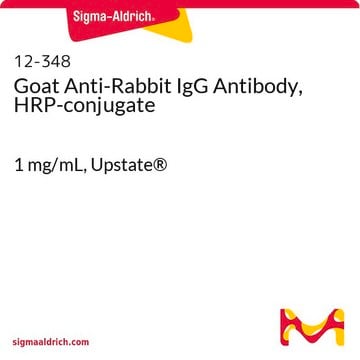400051
Hygromycin B
from Streptomyces sp., >85% (HPLC), liquid, aminoglycoside antibiotic, Calbiochem®
Sinônimo(s):
Hygromycin B, Streptomyces sp.
About This Item
Produtos recomendados
Nome do produto
Hygromycin B, Streptomyces sp., Unique aminoglycoside antibiotic that inhibits the growth of prokaryotic (bacteria) and eukaryotic microorganisms (yeasts) and mammalian cells.
Nível de qualidade
Ensaio
>85% (HPLC)
Formulário
liquid
fabricante/nome comercial
Calbiochem®
condição de armazenamento
OK to freeze
cor
amber to brown
Condições de expedição
ambient
temperatura de armazenamento
2-8°C
cadeia de caracteres SMILES
N([C@@H]1[C@H]([C@@H]([C@H]([C@@H](C1)N)O)O[C@@H]2O[C@@H]([C@@H]([C@@H]3OC4(O[C@@H]32)O[C@@H]([C@@H]([C@H]([C@H]4O)O)O)[C@@H](N)CO)O)CO)O)C
InChI
1S/C20H37N3O13/c1-23-7-2-5(21)9(26)15(10(7)27)33-19-17-16(11(28)8(4-25)32-19)35-20(36-17)18(31)13(30)12(29)14(34-20)6(22)3-24/h5-19,23-31H,2-4,21-22H2,1H3/t5-,6+,7+,8-,9+,10-,11+,12-,13-,14-,15-,16+,17+,18-,19+,20?/m1/s1
chave InChI
GRRNUXAQVGOGFE-KPBUCVLVSA-N
Descrição geral
Resistance to Hygromycin B is conferred by a gene coding for a phosphotransferase that phosphorylates Hygromycin B, thereby inactivating it (Bilang, R., et al., Malpartida, F., et al.). Hygromycin B is known to selectively penetrate cells that have been rendered permeable by virus infection. This, combined with its potency in inhibiting translation, makes it an effective antiviral agent (MacIntyre, G., et al., Zhou, J., et al.).
The analytical data listed below will vary from lot to lot.
Bioassay: 350-450 U/mg
Concentration: 444,600 U/ml; 394 mg Hygromycin B/ml
Density: 1140-1155 mg/ml
% solids: 34.6%
Fill volumes:
100,000 U = 225 µl
1,000,000 U = 2.25 ml
10,000,000 U = 22.5 ml
250,000 U = 562 µl
5,000,000 U = 11.25 ml
Ações bioquímicas/fisiológicas
growth of prokaryotic (bacteria) and eukaryotic microorganisms (yeasts) and mammalian cells
protein synthesis at the translocation step on the 70S ribosome and causes misreading of the mRNA
Advertência
Reconstituição
Note: This product is highly toxic. Read enclosed MSDS before handling.
Outras notas
Hamada, W., et al. 1994. Curr. Genetics 26, 251.
Hubbard, S. C., et al. 1994. J. Biol. Chem.269, 3717.
Rikkerink, E. H., et al. 1994. Current Genetics25, 202.
Sugimoto, K., et al. 1994. Plant J.5, 863.
Buchschacher, G.L., Jr., and Panganiban, A.T. 1992. J. Virol.66, 2731.
Gaken, J., et al. 1992. Biotechniques13, 32.
Lama, J., and Carrasco, L. 1992. J. Biol. Chem. 267, 15932.
Ma, H., et al. 1992. Gene117, 161.
MacIntyre, G., et al. 1992. Adv. Exp. Med. Biol.276, 67.
Norman, J.A., et al. 1992. Mol. Pharmacol.41, 53.
Bilang, R., et al. 1991. Gene100, 247.
Dale, E., and Ow, D. 1991. Proc. Natl. Acad. Sci. USA88, 10558.
Lee, M.G-S., and Van der Ploeg, L. 1991. Gene105, 255.
Leslie, J.F., and Dickman, M.B. 1991. Applied Environ. Microbiol.57, 1423.
MacIntyre, G., et al. 1991. Antimicrob. Agents Chemother.35, 2125.
Zhou, J., et al. 1991. Gene107, 307.
Bulte, L., and Bennoun, P. 1990. Current Genetics18, 155.
Giordano, T.J., and McAllister, W.T. 1990. Gene88, 285.
Salauze, D., et al. 1990. Antimicrob. Agents Chemother.24, 1915.
Carrasco, L., et al. 1989. Pharmacol. Ther.9, 311.
Crespi, C.L., et al. 1989. Carcinogenesis10, 295.
Damm, B., et al. 1989. Mol. Gen. Genetics217, 6.
Egelhoff, T.T., et al. 1989. Mol. Cell. Biol.9, 1965.
Kronstad, J.W., et al. 1989. Gene79, 97.
Perlin, D.S., et al. 1988. J. Biol. Chem.263, 118.
Cullen, D., et al. 1987. Gene57, 21.
Gonzalez, A., et al. 1978. Biochim. Biophys. Acta521, 459.
Malpartida, F., et al. 1983. Biochem. Biophys. Res. Commun.117, 6.
Rao, S.N., et al. 1983. Antimicrob. Agents Chemother.24, 689.
Informações legais
Palavra indicadora
Danger
Frases de perigo
Declarações de precaução
Classificações de perigo
Acute Tox. 1 Inhalation - Acute Tox. 2 Dermal - Acute Tox. 2 Oral
Código de classe de armazenamento
6.1A - Combustible acute toxic Cat. 1 and 2 / very toxic hazardous materials
Classe de risco de água (WGK)
WGK 3
Certificados de análise (COA)
Busque Certificados de análise (COA) digitando o Número do Lote do produto. Os números de lote e remessa podem ser encontrados no rótulo de um produto após a palavra “Lot” ou “Batch”.
Já possui este produto?
Encontre a documentação dos produtos que você adquiriu recentemente na biblioteca de documentos.
Os clientes também visualizaram
Active Filters
Nossa equipe de cientistas tem experiência em todas as áreas de pesquisa, incluindo Life Sciences, ciência de materiais, síntese química, cromatografia, química analítica e muitas outras.
Entre em contato com a assistência técnica




